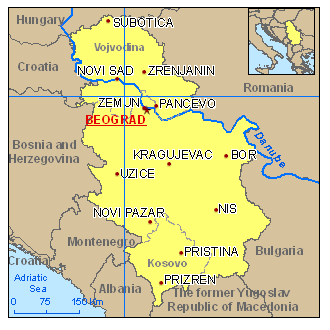September 4, 2012
by Ina Dimireva
— last modified January 30, 2017
Serbia – along with five other Western Balkan countries – was identified as a potential candidate for EU membership at the Thessaloniki European Council summit in 2003. In 2008, a European Partnership for Serbia was adopted, setting the priorities for the country’s membership application, and in 2009, Serbia officially applied. In March 2012, Serbia was granted EU candidate status. In September 2013, a Stabilization and Association AgreementSearch for available translations of the previous link••• between the EU and Serbia entered into force. In line with the European Council’s decision of June 2013 to open accession negotiations with Serbia, the Council adopted the negotiating framework in December 2013 and agreed to hold the first intergovernmental conference with Serbia in January 2014. January 21, 2014, the first intergovernmental conference The conference took place, marking the official start of Serbia’s accession negotiations.
Advertisement

Member of the Schengen area: No
Political system: Republic
Capital city: Belgrade
Total area: 77,474 km²
Population: 7.4 million
Currency: Serbian Dinar

Overview of the economy
Serbia has a transitional economy largely dominated by market forces, but the public sector remains important in some areas and many institutional reforms are needed. The economy is based on manufacturing and exports, driven largely by foreign investment. The mismanagement of the economy during the MILOSEVIC era, a long period of international economic sanctions, the civil war and the damage caused to Yugoslav infrastructure and industry during NATO airstrikes in 1999 did not left the economy only half of what it was in 1990.
After the ouster of former Yugoslav federal president MILOSEVIC in September 2000, the Democratic Opposition Coalition Government of Serbia (DOS) implemented stabilization measures and embarked on a market reform program . Serbia renewed its membership in the IMF in December 2000 and joined the World Bank and the European Bank for Reconstruction and Development. Serbia has made progress in trade liberalization and corporate restructuring and privatization, but many large companies – including electric utilities, telecommunications companies, natural gas companies and others – remain the state property. Serbia has made some progress towards EU membership, signing a Stabilization and Association Agreement with Brussels in May 2008 and, through the full implementation of the interim trade agreement with the EU in February 2010, it was granted candidate status in March 2012. In January 2014, Serbia’s EU membership negotiations were officially opened. Serbia’s negotiations with the WTO are advanced, with a total ban on trade and cultivation of biotech agricultural products representing the main obstacle to membership. Serbia’s program with the IMF was frozen in early 2012 because the 2012 budget approved by Parliament deviated from the program parameters; the agreement is now void. In late 2014, Serbia and the IMF announced an interim precautionary loan project worth around $1 billion, but the government will struggle to implement IMF-mandated reforms that will target social spending and the vast public sector.
High unemployment and stagnant household incomes are persistent political and economic problems. Structural economic reforms needed to ensure the country’s long-term prosperity have largely stalled since the start of the global financial crisis. Growing budget deficits are limiting the use of stimulus efforts to revive the economy and helping to fuel growing concerns about a public debt crisis, given that Serbia’s total public debt as a share of GDP has more than doubled between 2008 and 2014. Serbia’s concerns about inflation and exchange rates Stable rates prevent the use of expansionary monetary policy. In 2014, the SNS party addressed issues related to the budget deficit, state-owned enterprises, the labor market, building permits, bankruptcies, and privatizations, among other areas.
The main challenges ahead include: high unemployment rates and the need to create jobs; high public spending on wages, pensions, health care and unemployment benefits; a growing need for new public borrowing; the increase in public and private external debt; attract new foreign direct investment; and get the IMF program back on track. Other major long-term challenges include an ineffective justice system, high levels of corruption and an aging population. Favorable factors for Serbia’s economic growth include its strategic location, relatively inexpensive and skilled labor force and free trade agreements with the EU, Russia, Turkey and member countries of the Central European Free Trade Agreement.
Useful links
EU Delegation to the Republic of Serbia
Source: European Commission, The World Factbook
